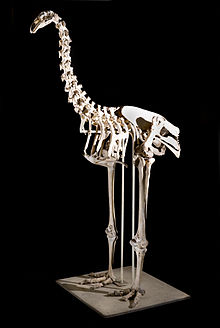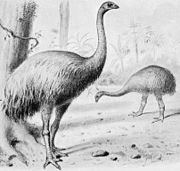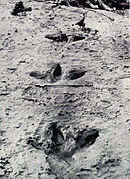|
South Island giant moa
The South Island giant moa (Dinornis robustus) is an extinct species of moa in the genus Dinornis, known in Māori by the name moa nunui.[2] It was one of the tallest-known bird species to walk the Earth, exceeded in weight only by the heavier but shorter elephant bird of Madagascar (also extinct).[citation needed] TaxonomyThe moa were large, flightless birds with a sternum, but without a keel: ratites.[a] They also had a distinctive jaw and palate. The origin of these birds is becoming clearer, and it is now believed that early ancestors of these birds were able to fly and flew to the southern areas in which they have been found.[3] Despite being located geographically closer to the kiwi, genetics show moas to have been closest to their sister group, the Central and South American tinamous. South island giant moas, as well as their close cousins on the North Island, are placed within their own family, Dinornithidae. These, along with the extinct upland moa and tinamous, are among the most basal members of the ratite order. DescriptionSizeThe South Island giant moa was the largest species of moa. Adult females stood up to 2 metres (6 ft 7 in) high at the back, and could reach foliage up to 3.6 metres (11 ft 10 in) off the ground, making them the tallest bird species known.[3][4] Despite their great height, Dinornis robustus was found to have weighed only 200 kilograms (440 lb) on average, with upper estimates of around ≥250 kilograms (550 lb) for females.[4] Only one specimen of complete or partially complete moa egg has been assigned to the South Island giant moa, found around Kaikōura. This egg, 240 millimetres (9.4 in) in length and 178 millimetres (7.0 in) in width, is the largest moa egg found in museum collections as of 2006.[5] AnatomyVery large-bodied, they had proportionately small heads, a trait synonymous with ratites. Analysis of their skull shows that they had somewhat poor eyesight due to their small orbits, rounded bills, and a very acute sense of smell thanks to a strongly developed olfactory system. Dinornis spp. had thinner leg bones than other moa, indicating that they were more agile than other moa, though they likely moved slowly and cautiously. Unusually, giant moas were the only large ratites that sported a hallux (digit 1). Uniquely, the moas were essentially wingless; the only remnant of a wing was the scapulocoracoid bone, which, at one point earlier in its evolution, was where the humerus should have been.  AppearanceGiant moas were likely fully feathered, except for their heads and a small portion of the neck, as well as the tarsus and feet. There have been feathers found belonging to this species, revealing that its plumage was plain brown or slightly streaked.[4] Behaviour and ecologyD. robustus, along with its relatives, were quite eccentric birds. Although they could reach 11+ feet in height, they mostly held their necks horizontally rather than vertically, like their distant relatives, the kiwi. FeedingMoa most likely filled a diurnal role in their ecosystem, similar to that of emus.[6] Because New Zealand lacked any native terrestrial, herbivorous mammals, the moas filled that niche. Giant moas in particular are ecologically equivalent to giraffes and other long-necked plant-eating megafauna, though they lack any living analogs in New Zealand. These birds sported a very robust bill, and finds of a relatively large collection of gizzard stone for grinding food, indicate a highly fibrous diet.[7] Most foraging took place in forests and open fields. Fossilized coprolites reveal the diet of D. robustus included twigs, seeds, berries, leaves, flowers, vines, herbs, and shrubs. It's likely that this species fed on vegetation that was unable to be digested by other species, therefore avoiding competition with other grazers.[8] Their bill allowed them to feed by means of cutting and breaking twigs and stems via lateral shaking. In addition to their bills, moas had stronger neck muscles than other ratite families, which might have given them a stronger pulling / tugging force.[9] They also could use their necks to reach higher levels, if necessary. ReproductionGiant moas likely were long-lived and took many years to reach full maturation. Similar to cassowaries, females likely were in competition for males, seeing that they were dramatically much larger. Likely similar to all other ratites, the males primarily reared the chicks, as the female would have been too large to incubate the weak-shelled eggs; however, their method of incubation is still unknown. As mentioned before, moas laid very easily breakable eggs. They nested in rock shelters from late spring to early summer. Chicks are speculated to have been striped, like those of other ratites. RangeIt lived on the South Island of New Zealand as well as in Rakiura[10] and Native Island[11] and its habitat was the lowlands (shrubland, duneland, grassland, and forests).[3] Along with other members of the moa family, the South Island giant moa went extinct due to predation from humans about 200 years after colonisation by Māori.[12] Footnotes
References
Other sources
External links
|
||||||||||||||||||||||||||||||||||||||



